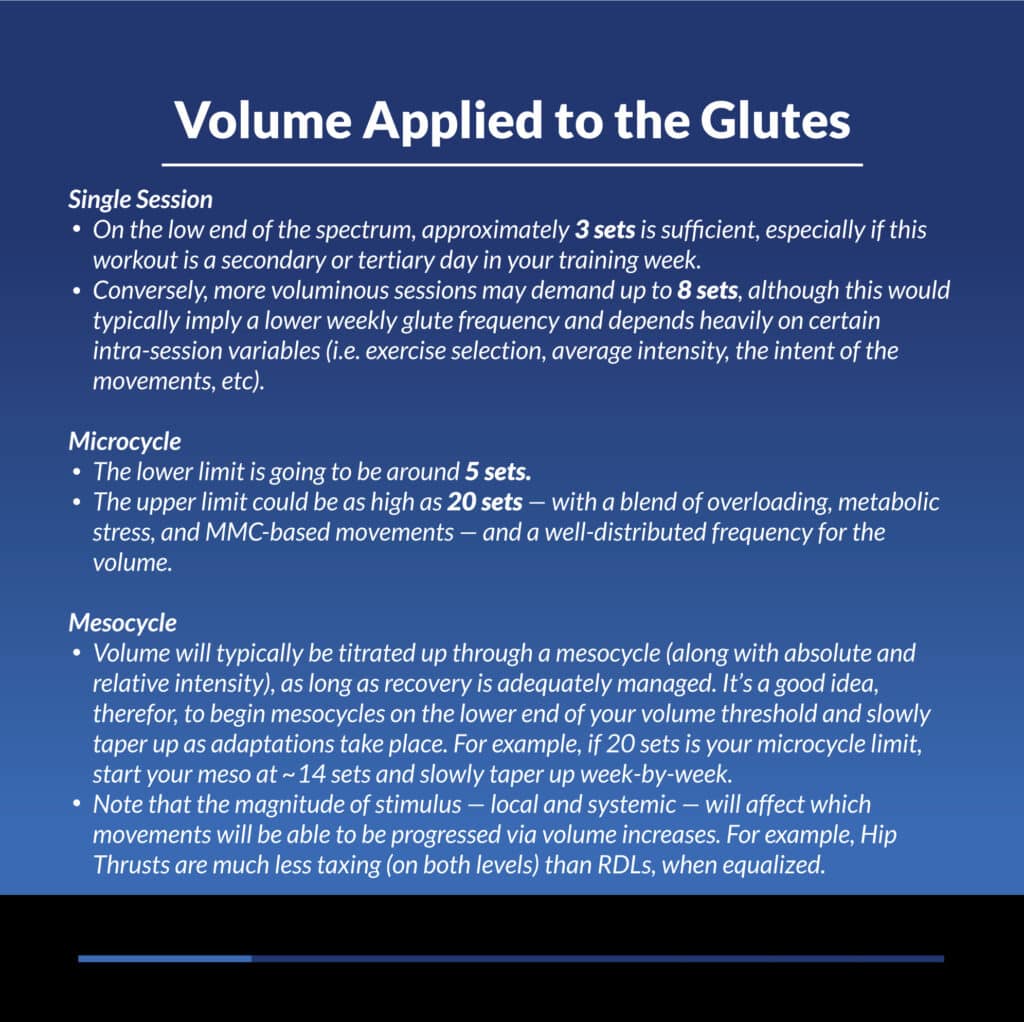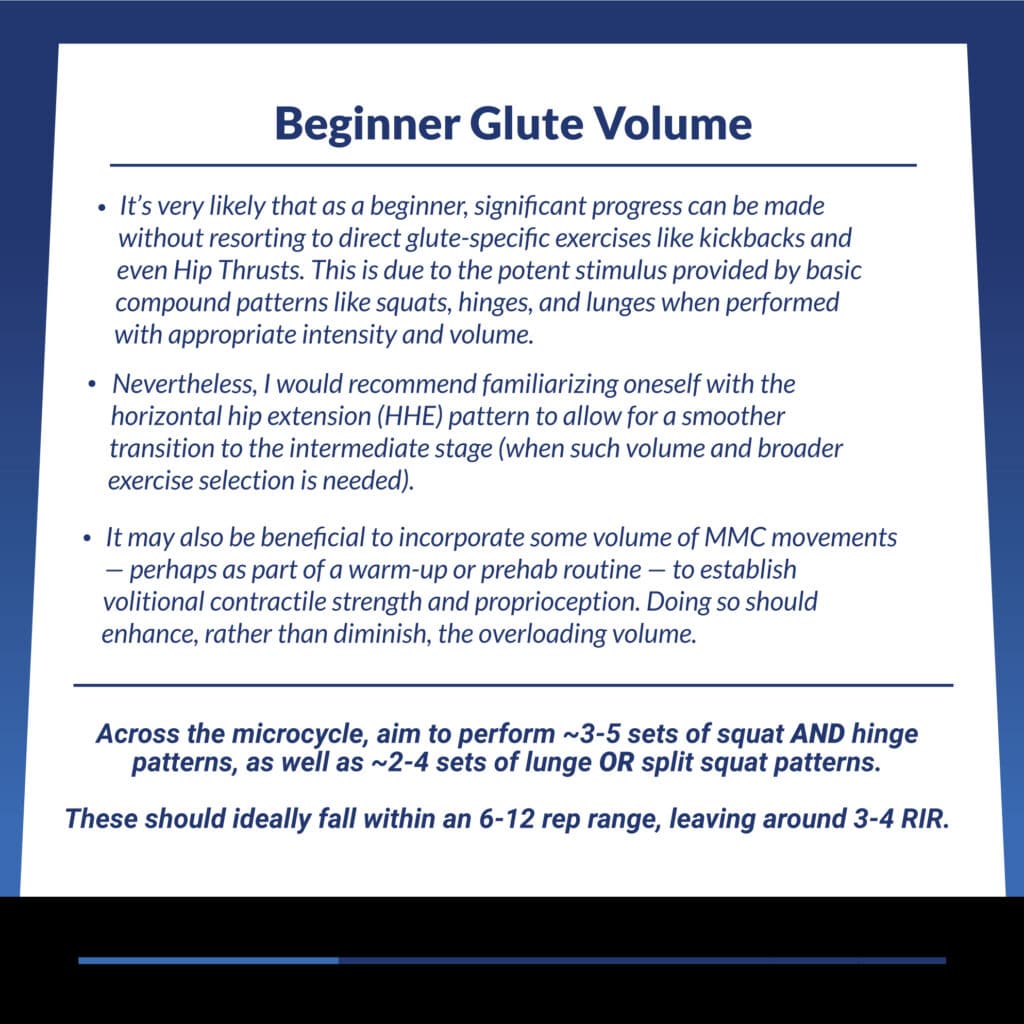Volume can mean different things for different people in different contexts. For clarity and simplicity, we’re going to use volume to refer to the number of direct sets above a minimum threshold of intensity.
Warm-up and feeder sets will not count towards our calculations, as these sets shouldn’t be performed with the requisite intensity to be considered working volume. For hypertrophy, it’s recommended to keep warm-ups, feeders, prehab, “activation” work, and other types of non-stimulative training to the minimal effective does in order to avoid creating unnecessary fatigue.
Likewise, indirect volume (i.e. sets that are performed with another muscle group as the primary target) will not be factored into these recommendations; though this does NOT mean that indirect volume shouldn’t be accounted for through more coarse-grained evaluations. For example, Heel Elevated Goblet Squats are a quad-dominant movement despite requiring assistance from the glutes—I would not count this towards direct glute volume. In other cases, the line between direct and indirect can be quite blurry so it may come down to a judgement call or individual differences. For example, Front Squats are clearly going to shift the bias of the movement towards the quads but the glutes are still getting heavily stimulated and thus, the volume should probably be classified as direct for the glutes.
Of additional note is the wide-ranging inter-individual differences with volume tolerances. I will be giving recommendations based off the middle of the bell curve (i.e. ranges that will be applicable to most people), but outliers in either direction will exist. One should start at the low end of the recommended range and evaluate their response and recovery—most will be able to taper that volume up over time, some will be able to take it beyond even the upper limits of what I’ve prescribed, while other will actually have to go lower than the floor of my recommendations in order to not overreach.
Lastly, all recommendations are based on meeting the sufficient intensity threshold in order to stimulate adaptations. This is going to be around ~4RIR for most people, and I would consider anything less than this to be of insufficient intensity (i.e. not a working set). Advanced and very strong individuals will be able to create more disruption per set, so they will generally need less volume to induce hypertrophic outcomes. And vice versa, intermediates and weaker trainees will generally need more volume to create the same magnitude of change (note: beginners will be able to make rapid progress due to the novelty effect and won’t need as much volume).

Single Session: On the low end of the spectrum, approximately 3 sets is sufficient, especially if this workout is a secondary or tertiary day in your training week. Conversely, more voluminous sessions may demand up to 8 sets, although this would typically imply a lower weekly glute frequency and depends heavily on certain intra-session variables (i.e. exercise selection, average intensity, the intent of the movements, etc).
Microcycle: The lower limit is going to be around 5 sets. The upper limit could be around 20 sets, with a blend of overloading, metabolic stress, and MMC-based movements, and a well-distributed frequency to the volume.
Mesocycle: We’ll delve into this more deeply in the Progression Models section, but suffice it to say for now, volume will typically be ramped up across a mesocycle (along with absolute and relative intensity), so long as recovery is adequately managed. It’s a good idea, therefor, to begin mesocycles on the lower end of your volume threshold and slowly taper up as adaptations take place. Note that the magnitude of stimulus (local and systemic) will affect which movements will be able to be progressed via volume increases—Hip Thrusts are much less taxing (on both levels) than RDLs, when equalized.



Beginners: It’s very likely that as a beginner, significant progress can be made without resorting to direct glute-specific exercises like kickbacks and even Hip Thrusts. This is due to the potent stimulus provided by basic compound patterns like squats, hinges, and lunges when performed with appropriate intensity and volume. Nevertheless, I would recommend familiarizing oneself with the horizontal hip extension pattern to allow for a smoother transition to the intermediate stage (when such volume and exercise expansion is needed). It may also be beneficial to incorporate some volume of MMC movements—perhaps as part of a warm-up or prehab routine—to establish volitional contractile strength and proprioception, though this should enhance rather than diminish the more overloading volume.
Across the microcycle, aim to perform ~3-5 sets of squat and hinge patterns, and ~2-4 sets of lunge or split squat patterns. These should ideally fall within an 6-12 rep range, leaving around 3-4 RIR.
Intermediates: By this stage, you will have developed a degree of volume tolerance, hence the need for additional workload to induce continual adaptations. A second training day could be introduced to distribute the volume—specifically, the glut volume—more evenly to allow for better recovery. Integration of HHE patterns (i.e. Hip Thrusts) becomes useful at this level for getting in specific volume. A broader rep range can be utilized to expand into untapped hypertrophic zones, and the average intensity can shift closer to failure.
Across the microcycle, the recommendation will change to ~3-5 sets of squat, hinge, and lunge/split squat patterns, coupled with ~2-4 sets of HHE movements. These should fall within the 5-20 rep range and 1-4 RIR, some of which can even be pushed to failure (when the R:R is conducive to doing so). Introducing direct hip abduction exercises can be useful at this stage, but their volume should not count towards your glute-specific volume, although the ensuing fatigue should still be accounted for.
Advanced: At this point, you might need to divide the volume even further to account for the increasing desensitization/tolerance to the volume, possibly by introducing a third glute-specific training day (especially if the program is catered towards the glutes). The total number of working sets will not increase significantly compared to the intermediate stage, and might even need to decrease due to the enhanced effectiveness, and subsequent fatigue, generated by each set. A greater chasm will develop between the intent underlying the volume (i.e. PO, MS, or MMC) to increase the effectiveness of each set of each exercise.
Across the microcycle, I would suggest ~3-5 sets each of squat, hinge, lunge/split squat, and HHE patterns. These should fall within an expansive 5-30 rep range, yet narrow 0-2 RIR—Intensity techniques can, and should, be applied to take some sets beyond failure when the R:R is conducive to doing so). Advanced athletes will also benefit from the inclusion of more refined exercise patterns like Machine Kickbacks, Single Leg Braced RDLs, and KB Swings in order to further round out the volume requirements.
